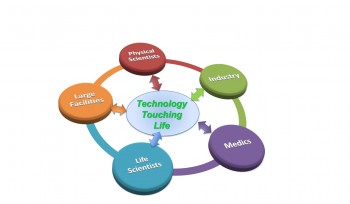News
Technology network awarded funding to capture musculoskeletal degeneration
15 April 2018
A group of universities, hospitals and research centres have been awarded funding to create a network seeking to develop new, high energy imaging methods to capture the dynamic biochemical and biophysical processes in biological samples. The human body is highly structured – from proteins and DNA, to the cells making up tissues that, in turn, form organs. To fully understand how an organ works in health and disease, imaging techniques need to be developed that simultaneously capture the dynamic biological processes at multiple temporal and structural scales.
Known as ImagingBioPro, the network will develop and apply imaging techniques to address this challenge. The focus will initially be on musculoskeletal degeneration from the molecular to the whole organism scale, but it will seek to develop methods that are applicable to many other conditions.
The network will be part of a major new Research Councils UK (RCUK) funding venture, Technology Touching Life, which aims to foster interdisciplinary research into innovative technology in the health and life sciences. Technology Touching Life is a joint initiative from the Biotechnology and Biological Sciences Research Council (BBSRC), the Engineering and Physical Sciences Research Council (EPSRC) and the Medical Research Council (MRC).
The ImagingBioPro Network is led by a team of leading academics and medics from eight different organisations spanning the breadth of physical, biological and medical science. It is inclusive and open to all researchers, clinicians and companies interested in developing, coupling and using dynamic imaging platforms, from electron microscopy to synchrotron techniques.
Professor Peter Lee, who leads the project explains “The challenge is coupling the high-energy imaging methods like synchrotrons with physiologically realistic environments. This network will bridge the huge temporal and spatial scales of biological processes such as musculoskeletal degeneration, helping translate these technologies to the laboratory and then the clinic.”
Biological tissues are hierarchical in both structure and function, and are constantly changing structural and chemical processes with time; these can range from elastic recoil in joint tissues during walking, to the tissue breakdown as we age, and to the very rapid secretion and reaction of proteins by cells in response to mechanical forces. A huge challenge is to understand what this hierarchy of processes is, as well as how they affect tissue functioning, growth and disease.
Currently, the physical-science and engineering methods used in the biomedical field lack the capacity to image these processes in a condition close to the living tissue and at multiple levels simultaneously. Recent advances in high-energy imaging methods at central research facilities, like synchrotrons, and in specialist methods, like 3D X-ray imaging and the use of free-electron lasers are changing this. These new techniques promise to capture molecules reacting at speeds orders of magnitude faster than previously possible.
This network will make this potential a reality by bringing together leading physical-science and engineering researchers with biomedical researchers to attack the engineering and biological challenges in a team-effort. It will provide funding for sandpits, workshops and conferences to bring scientists together to identify challenges, develop strategies to tackle them and to update on progress. Peer reviewed seed funding will also be available for exchanges between groups/disciplines, and for short duration feasibility studies, with a strong focus on engaging early career researchers.
Updated by: Ruikang Xue


